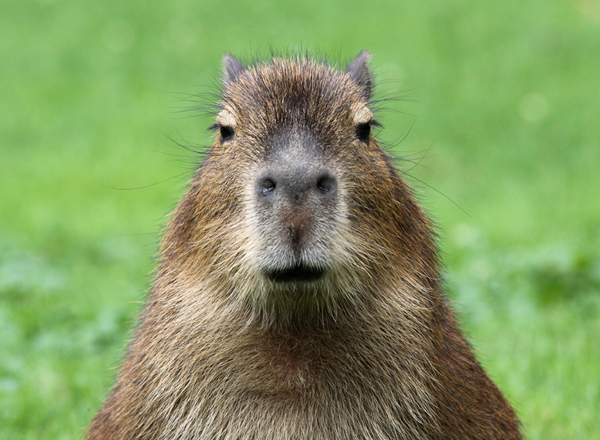Rogue Giant Rodent Caught On Camera In California

In some places, legend has it that chupacabras, abominable snowmen and other mythical beasts roam the countryside. In Paso Robles, Calif., folks tell tales of a legendary capybara.
The largest rodents in the world, capybaras live in South America and thrive in aquatic regions like the Amazon basin. How one member of the species made its way up to central California, no one knows. But it did. After years of speculative sightings , the rogue rodent has finally been caught on camera.
An estimated 100- to 120-pound specimen was first reported three years ago at a city golf course. According to Todd Tognazzini, a patrol lieutenant with California Dept. of Fish and Game, the report seemed absurd at the time, and the unidentified creature in question was taken to have been a beaver.
Then, less than two years ago, the capybara was seen chasing a Labrador retriever near a road. The dog's owner shot at it with a shotgun. "We didn't know if it was hit or not, but we had an investigator go out and confirm the footprints," Tognazzini told the local NBC News station. Because the capybara lay low for almost two years, everyone in the area thought it must have died in the scuffle.
But on July 22, the oversized rodent was spotted milling around a water treatment facility on the city's outskirts. "We discovered it one morning in our water ponds," said Chris Slater, a division supervisor at the Paso Robles Wastewater Treatment Plant. "They came up to tell me, and I said, 'Oh come on, you guys, what have you been smoking down there?'" As proof, the workers took photos of the small beast.
Apparently, one plant worker had seen the two-foot-tall animal swimming in the ponds before, but kept the strange scene to himself. "One operator said, 'I've seen him a couple times, but I didn't say anything because I didn't want you guys to think I was nuts,'" Slater said.
The Dept. of Fish and Game plan to live trap the capybara next time it appears. If recent history is anything to go by, though, the legendary creature will remain elusive.
Get the world’s most fascinating discoveries delivered straight to your inbox.
- Mythical Creatures: Beasts that Don't Exist (Or Do They? )
- 8 Weird Animal Facts
- "East River Monster" Is No Mutant
Follow Natalie Wolchover on Twitter @nattyover. Follow Life's Little Mysteries on Twitter @llmysteries, then join us on Facebook.
Natalie Wolchover was a staff writer for Live Science from 2010 to 2012 and is currently a senior physics writer and editor for Quanta Magazine. She holds a bachelor's degree in physics from Tufts University and has studied physics at the University of California, Berkeley. Along with the staff of Quanta, Wolchover won the 2022 Pulitzer Prize for explanatory writing for her work on the building of the James Webb Space Telescope. Her work has also appeared in the The Best American Science and Nature Writing and The Best Writing on Mathematics, Nature, The New Yorker and Popular Science. She was the 2016 winner of the Evert Clark/Seth Payne Award, an annual prize for young science journalists, as well as the winner of the 2017 Science Communication Award for the American Institute of Physics.



